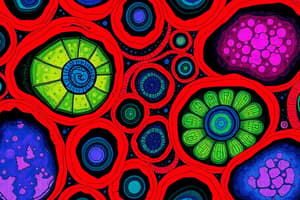Podcast
Questions and Answers
How many parts are there in a plant cell?
How many parts are there in a plant cell?
14
What is the function of the cell wall in a plant cell?
What is the function of the cell wall in a plant cell?
A rigid layer that surrounds the cells of plants and some other organisms.
What is cytoplasm?
What is cytoplasm?
A jellylike fluid inside the cell in which the organelles are suspended.
What does the cell membrane do?
What does the cell membrane do?
What is the function of lysosomes?
What is the function of lysosomes?
What is a vacuole?
What is a vacuole?
What is the nucleus in a plant cell?
What is the nucleus in a plant cell?
What is the role of the rough endoplasmic reticulum?
What is the role of the rough endoplasmic reticulum?
What is the nucleolus?
What is the nucleolus?
What is the smooth endoplasmic reticulum?
What is the smooth endoplasmic reticulum?
What does the nuclear membrane do?
What does the nuclear membrane do?
What are ribosomes?
What are ribosomes?
What is the function of chloroplasts?
What is the function of chloroplasts?
What are mitochondria known as?
What are mitochondria known as?
What is the function of the Golgi body?
What is the function of the Golgi body?
Flashcards
Cell Wall
Cell Wall
A rigid outer layer protecting plant cells.
Cytoplasm
Cytoplasm
Jelly-like fluid inside the cell where organelles are suspended.
Cell Membrane
Cell Membrane
Regulates the movement of substances in and out of the cell.
Lysosomes
Lysosomes
Signup and view all the flashcards
Vacuole
Vacuole
Signup and view all the flashcards
Nucleus
Nucleus
Signup and view all the flashcards
Rough Endoplasmic Reticulum
Rough Endoplasmic Reticulum
Signup and view all the flashcards
Nucleolus
Nucleolus
Signup and view all the flashcards
Smooth Endoplasmic Reticulum
Smooth Endoplasmic Reticulum
Signup and view all the flashcards
Nuclear Membrane
Nuclear Membrane
Signup and view all the flashcards
Ribosomes
Ribosomes
Signup and view all the flashcards
Chloroplasts
Chloroplasts
Signup and view all the flashcards
Mitochondria
Mitochondria
Signup and view all the flashcards
Golgi Body
Golgi Body
Signup and view all the flashcards
Study Notes
Parts of a Plant Cell
- There are 14 distinct parts that make up a plant cell.
Cell Wall
- A rigid layer surrounding plant cells and some organisms, providing structure and support.
Cytoplasm
- Jellylike fluid within the cell that suspends organelles, allowing for cellular processes.
Cell Membrane
- Thin, flexible barrier around the cell that regulates the entry and exit of substances.
Lysosome
- Small, round structures containing enzymes that digest large food particles into smaller components.
Vacuole
- Water-filled sac serving as a storage area for nutrients, waste products, and other materials.
Nucleus
- Known as the brain of the cell; it houses genetic material and oversees cellular activities.
Rough Endoplasmic Reticulum
- Network of membranes involved in protein synthesis, characterized by ribosomes on its surface.
Nucleolus
- A dense region within the nucleus where ribosomal RNA is produced and assembled.
Smooth Endoplasmic Reticulum
- Membrane network that synthesizes lipids and detoxifies certain chemicals, lacking ribosomes.
Nuclear Membrane
- Double-layered membrane that surrounds the nucleus, controlling the movement of materials in and out.
Ribosomes
- Small organelles found in the cytoplasm where protein synthesis occurs; often depicted as tiny dots.
Chloroplast
- Organelles in plant cells that capture sunlight to convert it into chemical energy via photosynthesis.
Mitochondria
- Powerhouses of the cell generating energy through cellular respiration, essential for various cellular functions.
Golgi Body
- Structure that modifies, packages, and distributes proteins and other materials received from the endoplasmic reticulum.
Studying That Suits You
Use AI to generate personalized quizzes and flashcards to suit your learning preferences.




